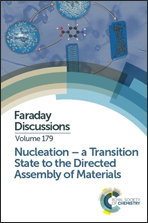Formation of new polymorphs without any nucleation step. Desolvation of the rimonabant monohydrate: directional crystallisation concomitant to smooth dehydration†
Abstract
Rimonabant monohydrate can be dehydrated at 100 °C or above with complete loss of structural information; in this case the amorphous material can lead to nucleation and crystal growth. The water molecules can also be removed by a smooth process below Tg (78 °C) of the anhydrous phase. In that latter process there is a structural filiation between the mother phase and the daughter phase. The solvent molecules escape from the mother structure by using a network of specific channels; the new non-solvated material undergoes a relaxation process similar to a directional crystallization. By this soft mode of desolvation inside a material which has a very limited mobility, the nucleation of a non-solvated material can be avoided. The structural information contained in the mother phase is not used as a template for crystal growth but it is more a progressive rearrangement of the new desolvated material towards the nearest well in energy. Thus, a metastable new polymorph of a non-solvated component can be obtained by: (i) the crystallization of the component as a solvate and (ii) a smooth desolvation at T < Tg. Other parameters liable to interfere with that transmission of structural information are discussed.
- This article is part of the themed collection: Nucleation – a Transition State to the Directed Assembly of Materials

 Please wait while we load your content...
Please wait while we load your content...